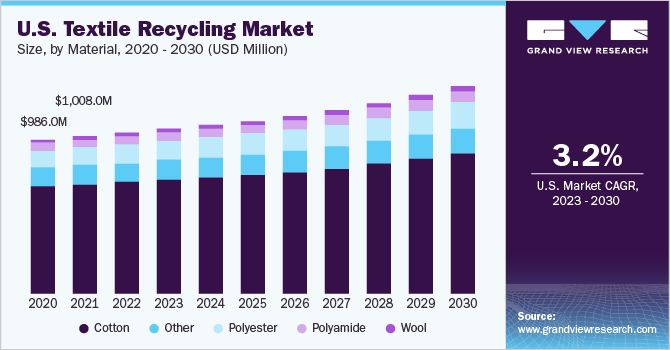The global textile recycling market was valued at approximately USD 4,632.4 million in 2022 and is projected to grow at a compound annual growth rate (CAGR) of 3.2% from 2023 to 2030. This growth is largely driven by rising environmental concerns regarding textile waste and increasing social awareness about the importance of textile recycling. According to the Environmental Protection Agency (EPA), around 5% of landfill space is filled with textile waste. In the United States, an estimated 25 billion pounds of textiles are produced annually, which translates to approximately 82 pounds per person. These factors are expected to significantly boost the demand for textile recycling in the coming years.
Textile waste recycling plays a crucial role in promoting environmental sustainability. One effective recycling method is upcycling, which maximizes the conservation of resources such as water, raw materials, and energy, while minimizing environmental impacts. Additionally, recycling textiles has a lower environmental footprint compared to incineration or landfill disposal. By replacing products made from virgin materials, resource recovery can yield substantial environmental benefits. All these elements are anticipated to positively influence market growth over the forecast period.
Moreover, the rising global population and increasing consumer spending capacity are likely to lead to greater textile waste generation, raising concerns about effective waste management. Many government agencies and private companies are viewing textile recycling as a viable solution to address these challenges and promote a circular economy. According to a report by the U.S. Environmental Protection Agency in 2022, the recycling rate for all textiles in the country stood at 14.7% in 2018, highlighting the potential for improvement in this sector.
Gather more insights about the market drivers, restrains and growth of the Textile Recycling Market
Source Insights
By source, the apparel waste segment represented 28.9% of the global textile recycling revenue in 2022. This segment includes waste generated from leftover fabric during manufacturing, damaged or rejected garments, and post-consumer discarded clothing and footwear. Over the past two decades, the average lifespan of new garments has significantly decreased, leading to increased waste generation within the apparel industry. These dynamics are expected to further fuel the demand for recycling within this sector.
Home furnishing waste, which encompasses textiles generated from items such as pillows, carpets, rugs, bedsheets, curtains, and sofas, is another growing segment. Increased disposable income worldwide has led to higher spending and more frequent purchases of these products, resulting in greater home furnishing waste. Factors contributing to this trend include population growth, a wider variety of home furnishings, and improved living standards, all of which generate substantial post-industrial and post-consumer waste in this category. These elements are projected to drive demand for recycling of home furnishing textiles.
The automotive waste segment is expected to grow at a CAGR of 3.3% during the forecast period. Textiles used in vehicles, including carpets, seat covers, cushions, roof liners, door liners, tires, filters, and airbags, contribute to automotive waste. The rise in vehicle ownership in developing countries is exacerbating the issue of automotive waste. Initiatives aimed at managing automotive textile waste are likely to positively impact market growth.
Stuffed toys also fall under the category of textiles suitable for recycling. According to the Secondary Materials and Recycled Textiles Association (SMART), only 15% of textiles in the U.S. are donated for reuse or recycling. Annually, the average American family discards about 324 pounds of unwanted textiles, including stuffed toys. In 2021, Bank & Vogue Ltd. successfully recycled approximately 1,400,000 pounds of toys. Additionally, SK-Tex has recycled clothing into materials for car seat upholstery filling, furniture insulation, and ECO building insulation. These trends are expected to enhance the demand for recycling initiatives focused on items such as sailing and fishing nets, insulation materials, and stuffed toys.
Order a free sample PDF of the Textile Recycling Market Intelligence Study, published by Grand View Research.


